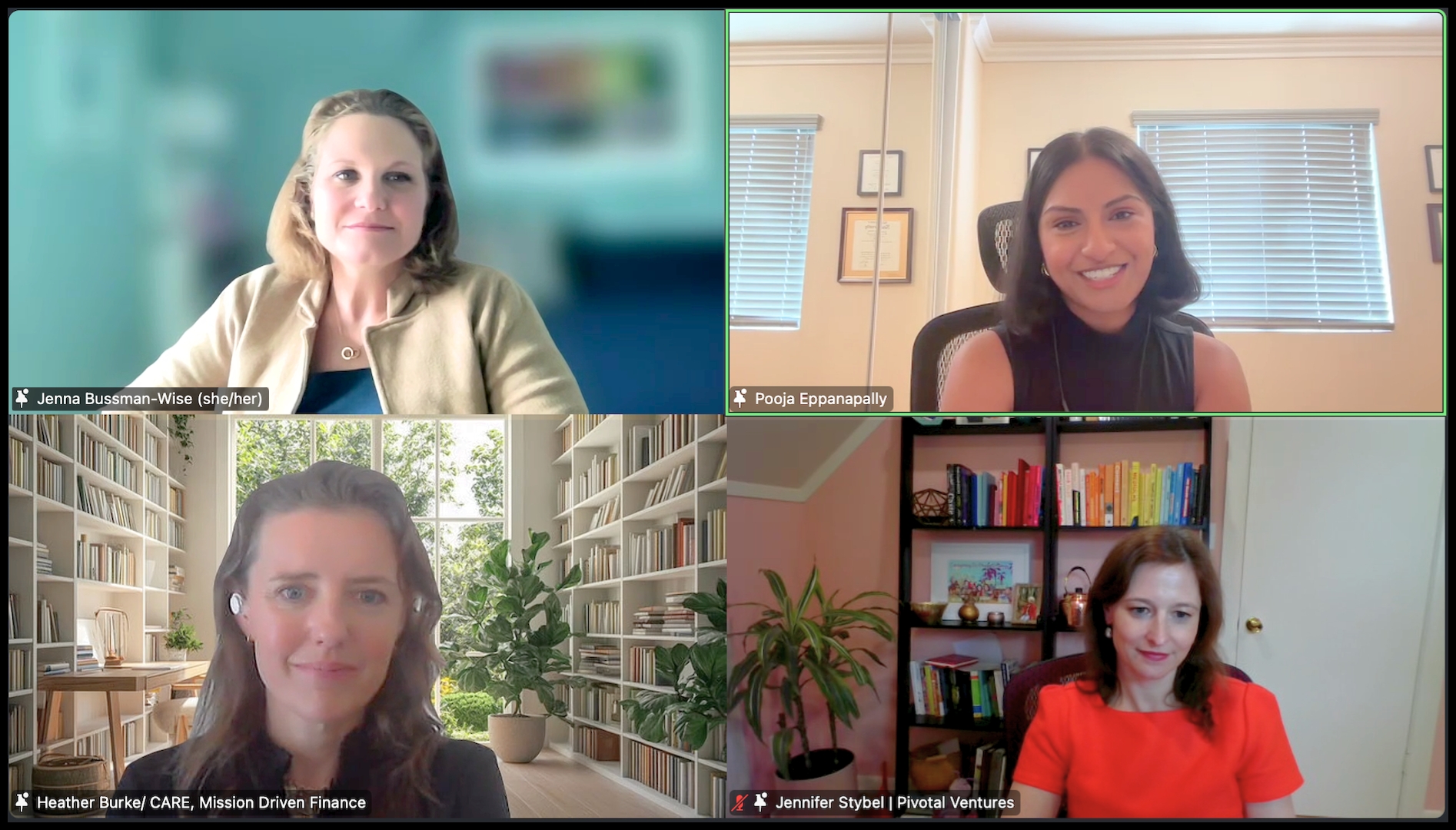“My mom is 81. I have a daughter who’s three.”
Jenna Bussman-Wise’s personal experience instantly elicited nods at our recent panel on investing in the care economy.
The sandwich generation, or maybe more accurately, the panini generation—crushed by the pressures of caring for both aging parents and young children—feels familiar to many.
Yet, the care economy remains a massively underinvested opportunity hiding in plain sight.
Heather Burke of Care Access Real Estate® (CARE) brought together a panel of experienced practitioners to discuss this investment landscape, centered around the recent white paper Caring for Tomorrow: A Guide to Investing in the Care Economy:
- Jenna Bussman-Wise, Tesser Capital Management
- Pooja Eppanapally, formerly Women of the World Endowment
- Jennifer Stybel, Pivotal Ventures
- Heather Burke, Care Access Real Estate, Mission Driven Finance (moderator)
The care economy: a massive, overlooked market “hidden in plain sight”
Here’s the math that should keep every investor awake at night:
Everyone needs care, few can afford it, and hardly anyone is actively investing in solutions.
Families with young children struggle to find child care that’s both affordable and logistically feasible. Home care for aging or disabled individuals remains out of reach for families who desperately need it. Meanwhile, an aging population and caregiver shortages are creating a perfect storm of demand that shows no signs of slowing.
One stark consequence: “In effect, the wage gap is really a care gap,” explained Jennifer Stybel. When families can’t access affordable care, someone—usually women—leaves the workforce. The ripple effects touch every corner of the economy.
Pooja Eppanapally put it simply:
“Caregivers make all other work possible. [The shortage of care options] affects all of us, and it’s going to take all of us to come up with scalable solutions in this space.”
Yet despite being a $649 billion market that touches every family, workplace, and community, the care economy remains largely invisible to mainstream investors. That disconnect between widespread need and capital allocation? That’s an opportunity.
What can investors and institutions do?
The beauty of the care economy investing opportunity lies in its breadth and flexibility. There is space for philanthropic grants to de-risk early ventures, impact-first investments, market-rate private equity to scale proven solutions, and everything in between. Panelists shared various approaches to engage with the care economy.
The full-spectrum investment approach
Think of care economy investing as building an ecosystem. As noted in the white paper, philanthropic capital creates proof points, blended finance models reduce risk for institutional investors, and market-rate capital scales what works. Each type of investment enhances the others.
- Infrastructure plays: Funds like Care Access Real Estate® (CARE) help solve the real estate puzzle that hampers child care operations from growing
- Technology solutions: Direct investments in companies like Clasp, Tilt, Little Otter, Summer Health and Mon Ami are building platforms that caregivers need*
- Venture-focused funds: Specialized funds like Kalos Ventures zero in on the unique dynamics of care, workforce, and education*
- Public-private partnerships: Strategic blending of government resources with private capital can fill gaps in public investment and may strengthen future policy recommendations affecting the care economy
The policy-innovation-capital triangle
Stybel captured the interconnected nature of this opportunity:
“We know that in order to achieve lasting change in this area, we need new and better policies. We need more tech innovation and, therefore, more investment going into the space. We need catalytic philanthropic funding to take risks on new ideas and create proof points.”
Translation for investors: This isn’t just about picking winning companies or fund managers. It’s about positioning capital where policy implementation, tech breakthroughs, and market demand intersect.
Your 5-point action plan
Ready to explore care economy investing? Start here.
- Examine your current portfolio: What exposure do you already have to the care economy? Understand what you already own to determine what you do next.
- Consider intentional care investments: Start with one if you have none.
- Challenge your advisors: Ask them to apply a “care economy lens” to your existing strategy. If they’re not sure what that is, share the Caring for Tomorrow white paper!
- Break down internal siloes: Ex. Foundations can align investing and grantmaking teams around shared care economy goals.
- Become a strategic partner: Get to know the entrepreneurs and operators in this space, and get to know the context of their capital needs.
Right-size your investment strategy with the intended impact. As Bussman-Wise emphasized, “Patient capital around a mission is imperative.”
Growing the care economy is vital for us all. It requires collaboration across sectors, patient capital, and innovative financing models to create systemic change, but there are bright spots that show what’s possible when we work together.
For further exploration
- Caring for Tomorrow white paper (see Appendix C for investible themes & examples)
- The Holding Co. 2025 Care Trends Report
- The Holding Co. Investor’s Guide
- Care Access Real Estate® (CARE) / Downloadable PDF
- Pivotal Ventures: Support for Caregivers is Finally Growing. Let’s Build On That Momentum.
- Harvard Business Review: Your Company Needs an Eldercare Policy
- Roosevelt Institute: “Have You Ever Considered How You Might Transition Your Business to a New Owner?” The Need for Publicly Supported Childcare Ownership Transition Models
- BCG report: Solving the $290 Billion Care Crisis
- BCG report, Moms First, 2024
- Moms First
- PaidLeave.ai
- Employer Child Care Navigator
- Caring Across Generations
- Care Can’t Wait
- Magnify Ventures
- UrbanSitter
- FamTech.org
- Care Summit
- Dreamers & Doers
- Healthy Outcomes
- Real Estate’s Role in Child Care
*Mission Driven Finance is not affiliated with these companies or funds and has not conducted due diligence on them as of this writing. Consult your advisors to determine what, if any, investments make sense for your context.
Disclosure: This communication is for informational purposes only and does not constitute an offer to sell, a solicitation to buy, or a recommendation for any security.


